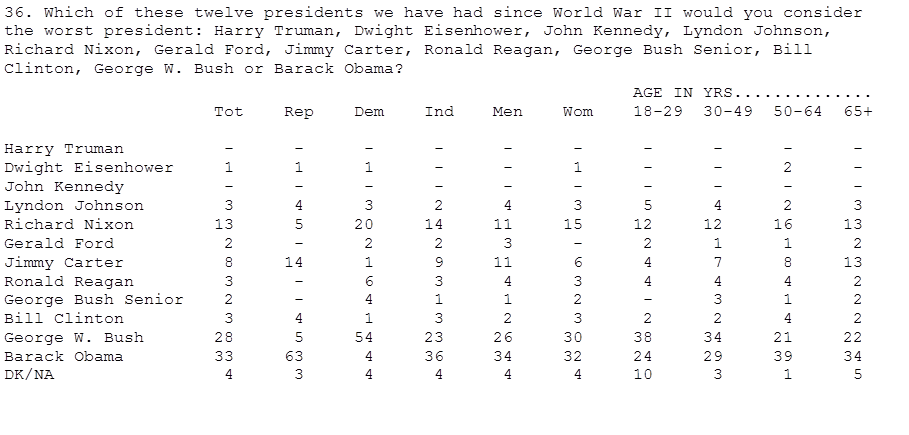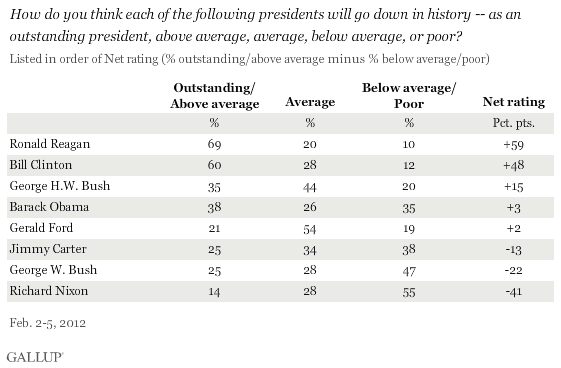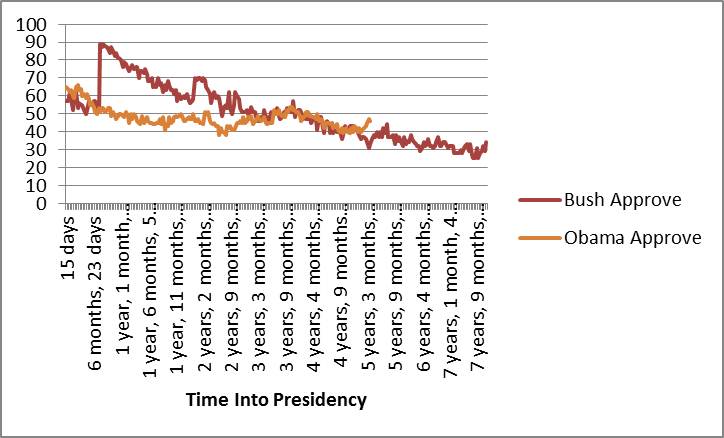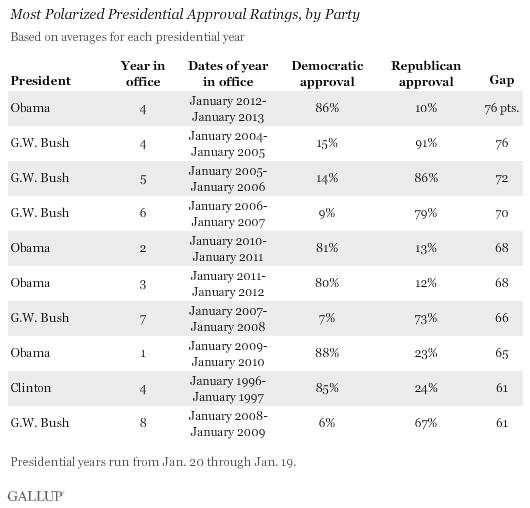I’ve received several requests to post something about this Quinnipiac survey of American adults released yesterday in which 33% of respondents say Barack Obama is the worst president among the 12 who have served since World War II. That tops the list of worst presidents, beating even former president George W. Bush, who 28% chose as the worst. Ronald Reagan was chosen as the best president among the 12 by 35% of those polled. If the results weren’t bad enough for Obama, 45% of respondents say America would be better off if Republican Mitt Romney had won the 2012 presidential election, compared to 38% who believe the country would be worse off. (The survey, which called both land lines and cell phones, was in the field from June 24 – 30, and has a margin of +/- 2.6 percentage points.)
The results have received a great deal of play among pundits on the interwebs, so it is probably useful to put them in some perspective. To begin, the survey asks respondents to name the best and the worst among the dozen post-World War II presidents – it does not give respondents a chance to evaluate these presidents in an absolute sense by, for example, rating presidents on a scale from outstanding to below average, which is what Gallup does (more on Gallup below). So finding that Obama is the worst of the post-World War II lot doesn’t necessarily tell us what respondents think of him outside a comparative perspective. How bad is bad? Note also that 8% of respondents rate him as the best president in this era, which places him 4th in this category, behind only Reagan, Clinton (18%), and JFK (15%).
Still, it is hard to view these results as a ringing endorsement of the Obama presidency, so it worth understanding what seems to be driving the response. To begin, Quinnipiac breaks down their respondents into four age groups: 18-29, 30-49, 50-64, and 65 and older. As Phillip Bump notes here, there is a distinct age-related pattern to the responses, with Obama’s support generally decreasing as one moves up the age categories. (In contrast, G. W. Bush’s support shows the opposite age-related trend; younger respondents think less highly of him.) Here is the distribution of responses to the question asking to name the worst president:
 Note also that Obama does better (less badly) among Democrats who are much more likely to cite G. W. Bush or Nixon as the worst president. Interestingly, there’s not much gap at all between men and women, with pluralities of both choosing Obama as the worst president among the 12.
Note also that Obama does better (less badly) among Democrats who are much more likely to cite G. W. Bush or Nixon as the worst president. Interestingly, there’s not much gap at all between men and women, with pluralities of both choosing Obama as the worst president among the 12.
So, what seems to be driving these results? One clue is provided by looking at comparable polls, such as Gallup’s, which asks respondents to categorize presidents on a five-point scale from Outstanding to Below Average. If we combine the two highest and two lowest categories, and subtract the difference, the two presidents who show the biggest net positive approval gap are Ronald Reagan and Bill Clinton – the same two who top Quinnipiac’s “best president” category. (Note that John F. Kennedy is not on this Gallup list, but he had the biggest positive approval gap in a 2013 Gallup survey which went in the field on the 50th anniversary of JFK’s assassination.)

Moreover, that positive gap has been growing larger for both presidents since they were first included on Gallup’s survey asking the public to evaluate the most recent presidents. (I’ll show some data in my next post showing these trends.) Based on this question, Obama ranks 4th among presidents according to the net positive approval gap.
One is tempted, of course, to dismiss any poll that rates Bill Clinton, one of only two presidents to be impeached, so favorably. Elsewhere I’ve discussed at length some of the difficulties with asking the public, and academics for that matter, to rate the presidents. Still, I wouldn’t dismiss the Quinnipiac or Gallup results entirely. Note that both Reagan and Clinton are remembered for presiding during a period of sustained economic growth. Indeed, some of Clinton’s highest approval ratings came during the Lewinsky impeachment proceedings, in part because the public placed much more importance on the state of the economy than they did the state of Clinton’s zipper. Fairly or not (and longtime readers know I think it is unfair), we tend to hold the president accountable for the state of the economy as it is (and not how it might have been under different circumstances). This is particularly true as one becomes increasingly invested in the economy. In the Quinnipiac poll, fully 45% of respondents cited the economy, jobs or the budget as the most important issue facing the country, with another 6% citing health care costs. This is by far the most highly cited category. In contrast, only 3% cited “war” or “terrorism” and only 1% cited “class inequality”, “lack of religion”, or “family values”. Moreover, it is the older respondents who have the more negative view toward the economy which likely explains their more pessimistic attitude toward Obama’s performance.
 It bears repeating that the issues the pundits tell us matter (see the Hobby Lobby court decision!) don’t really resonate with most voters, particularly when it comes to evaluating presidential performance. As my students have heard me say repeatedly, the President more than any other elected official embodies national sovereignty. As such, his fate is closely intertwined with how the public views the state of the nation. To date, Obama has presided over a middling economic recovery, one characterized by incremental growth and sustained unemployment. Yes, Tim Geithner may be correct that in bailing out the banks and pushing a stimulus bill through Congress Obama averted a deeper economic calamity. But the fact remains that Americans are dissatisfied with the pace of economic growth during the Obama presidency and that dissatisfaction is largely responsible for the results of the Quinnipiac poll.
It bears repeating that the issues the pundits tell us matter (see the Hobby Lobby court decision!) don’t really resonate with most voters, particularly when it comes to evaluating presidential performance. As my students have heard me say repeatedly, the President more than any other elected official embodies national sovereignty. As such, his fate is closely intertwined with how the public views the state of the nation. To date, Obama has presided over a middling economic recovery, one characterized by incremental growth and sustained unemployment. Yes, Tim Geithner may be correct that in bailing out the banks and pushing a stimulus bill through Congress Obama averted a deeper economic calamity. But the fact remains that Americans are dissatisfied with the pace of economic growth during the Obama presidency and that dissatisfaction is largely responsible for the results of the Quinnipiac poll.
Of course, as I’ve noted on many occasions, asking people to evaluate a president while he is in office is problematic. I suspect many respondents to the Quinnipiac poll put far more emphasis on the here and now when rating presidents rather than on past circumstances, such as the stagflation that characterized Carter’s presidency, for instance. We will be better positioned to see how Obama is rated only when the public gets some distance from his presidency. Unless those economic numbers improve dramatically, however, I suspect Obama will not be chosen by very many respondents as the best president in the modern era. In the end, when it comes to presidential evaluations or presidential elections, it remains the fundamentals, stupid.



